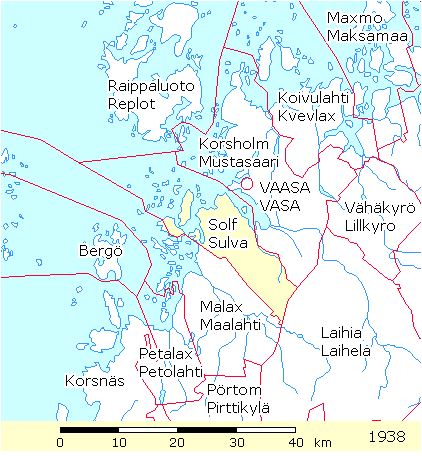Ostrobothnia
Solf
Parish History
- Solf originally was a part of the Malax parish 7
- In the 1700’s it became an independent parish 1
Of Interest
There is an old story that says the name of the city came from one of two surviving crew member from a German ship wrecked at sea near the coast of today’s Solf. The crew members name was Solf or Sylf. 4
Historic Villages
The historic villages of Solf include:
- Munsmo
- Rimal
- Väster-Solv
- Yttersundom (Outside Sundom)
- Öster-Solv
- Över-Sundom
Because parish Communion records are listed by farm name and because farm names often were used as a part of a person’s name, it is interesting to note the following farms.
The villages and farms of Solf were recorded in T.W. Karsten’s work, Svesk Bygd I Osterbotten: Nu Och Fordom. 3 Solf Parish Communion records were not used to confirm these findings.
To print a copy of the villages and farms, click here.
Farms
- Hellman
- Väster
- Båssars
- Norrgramm
- Snåvs
- Rimal
- Berg
- Helenlund
- Skogs
- Busk
- Rullas
- Klockars
- Söderman
- Pått
- Bav
- Lindmans
- Väst
- Östman
- Staffans
- Hårtans
- Sund
- Backholm
- Östergård
- Båtmästar
- Falk
- Björs
- Berg
- Huggar
- Mitts
- Enholm
- Marins
- Svarvar
- Släthår
- Mitts
- Sköring
- Lervik
- Finne
- Uppgård
- Nedergård
- Hinders
- Krypar
- Jåvs
- Martins
- Kars
- Ryss
- Tors
- Näsman
- Buss
- Snickars
- Hemming
- Genas
- Gästgivars
- Mara
- Sassi
- Ånäs
- Perus
- Skinnars
- Pått
- Övermo
- Nedermo
- Majors
- Helgas
- Finne
- Lall
- Näs
- Stundars
- Anneberg
References
- Appelgren, A. and G. Rosenholm, Solf Kyrka Och Dess Minnen, Solf Församlings Förlag, Vasa, 1948
- Genealogical Society of Finland, HisKi project, Solv parish, http://hiski.genealogia.fi/hiski/a24txq
- Karsten T.W., Svesk Bygd I Osterbotten: Nu Och Fordom; Helingfors, 1923, pages 77 – 82
- Solf, https://sv.wikipedia.org/wiki/Solf
- Solf Church image, https://commons.wikimedia.org/wiki/File:Korsholm_-_Solf_Church_-_20160726143142.jpg
- Solf Folk Costume image, Brage costume agency, https://www.brage.fi/sve/draktbyra/draktbyran/folkdrakter/view-163648-100
- Solf Forsamling, http://www.solfsforsamling.fi/
- Stranden, Evald, “Den Osterbottniska Byn”, Solf Church Village, translated by June Pelo




